TESCO's Operations and Service Management: A Detailed Report
VerifiedAdded on 2023/01/04
|9
|3237
|50
Report
AI Summary
This report offers a comprehensive analysis of TESCO's operations and service management, focusing on key aspects such as operational performance, management practices, and the strategic application of technology. The report begins by identifying operational management techniques employed by TESCO, evaluating their impact on the company's efficiency, and exploring the potential of technology in processing and implementing operations. It then delves into the analysis of management practices, including the Hayes and Wheelwright Model, and the role of process design. The report also emphasizes the importance of linking supporting functions to operations management to achieve organizational goals, including the utilisation of resources and the implementation of quality management techniques to meet customer expectations. Overall, the report provides a detailed overview of TESCO's operational strategies and their impact on the company's success within the competitive retail industry.
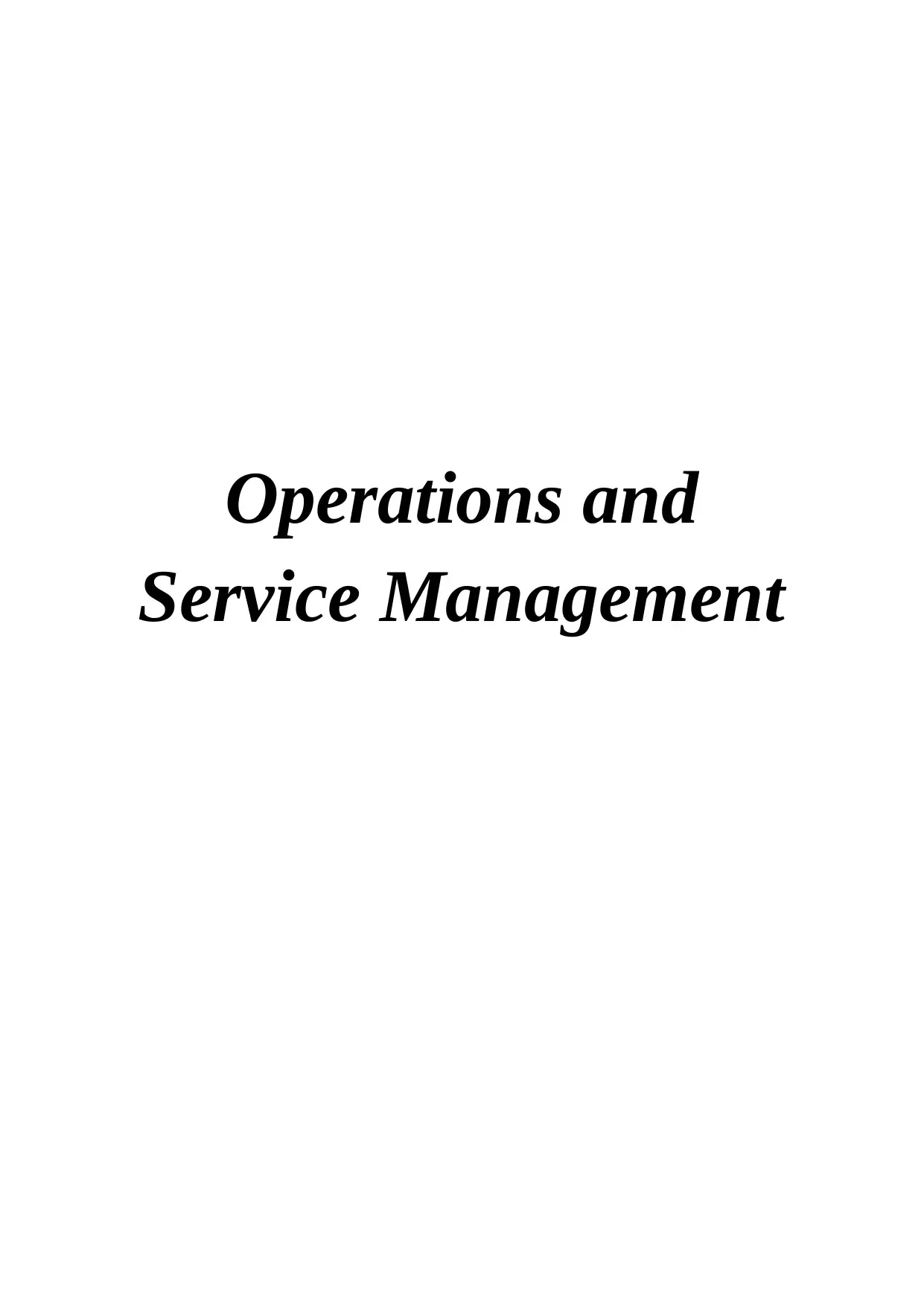
Operations and
Service Management
Service Management
Paraphrase This Document
Need a fresh take? Get an instant paraphrase of this document with our AI Paraphraser
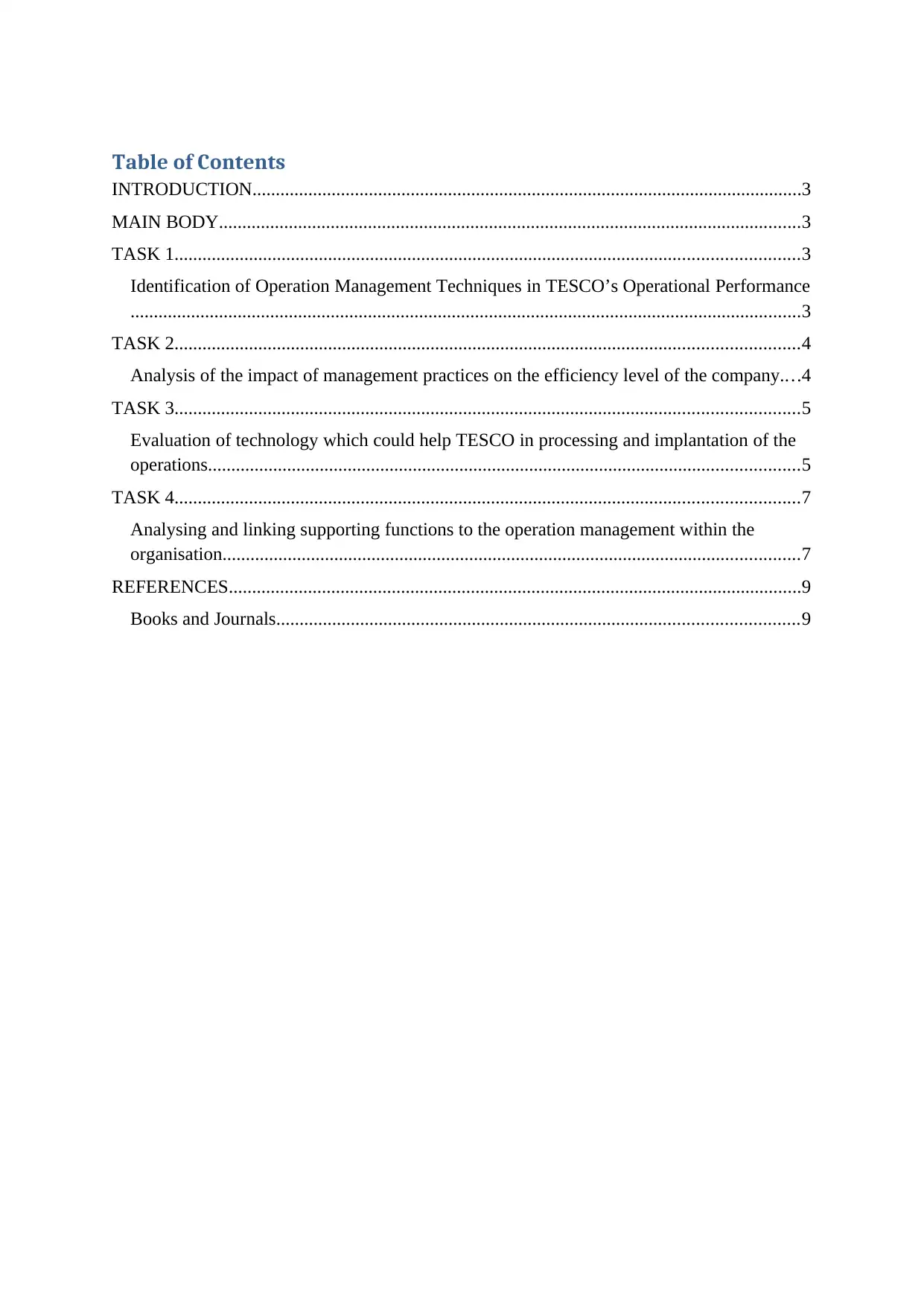
Table of Contents
INTRODUCTION......................................................................................................................3
MAIN BODY.............................................................................................................................3
TASK 1......................................................................................................................................3
Identification of Operation Management Techniques in TESCO’s Operational Performance
................................................................................................................................................3
TASK 2......................................................................................................................................4
Analysis of the impact of management practices on the efficiency level of the company....4
TASK 3......................................................................................................................................5
Evaluation of technology which could help TESCO in processing and implantation of the
operations...............................................................................................................................5
TASK 4......................................................................................................................................7
Analysing and linking supporting functions to the operation management within the
organisation............................................................................................................................7
REFERENCES...........................................................................................................................9
Books and Journals................................................................................................................9
INTRODUCTION......................................................................................................................3
MAIN BODY.............................................................................................................................3
TASK 1......................................................................................................................................3
Identification of Operation Management Techniques in TESCO’s Operational Performance
................................................................................................................................................3
TASK 2......................................................................................................................................4
Analysis of the impact of management practices on the efficiency level of the company....4
TASK 3......................................................................................................................................5
Evaluation of technology which could help TESCO in processing and implantation of the
operations...............................................................................................................................5
TASK 4......................................................................................................................................7
Analysing and linking supporting functions to the operation management within the
organisation............................................................................................................................7
REFERENCES...........................................................................................................................9
Books and Journals................................................................................................................9
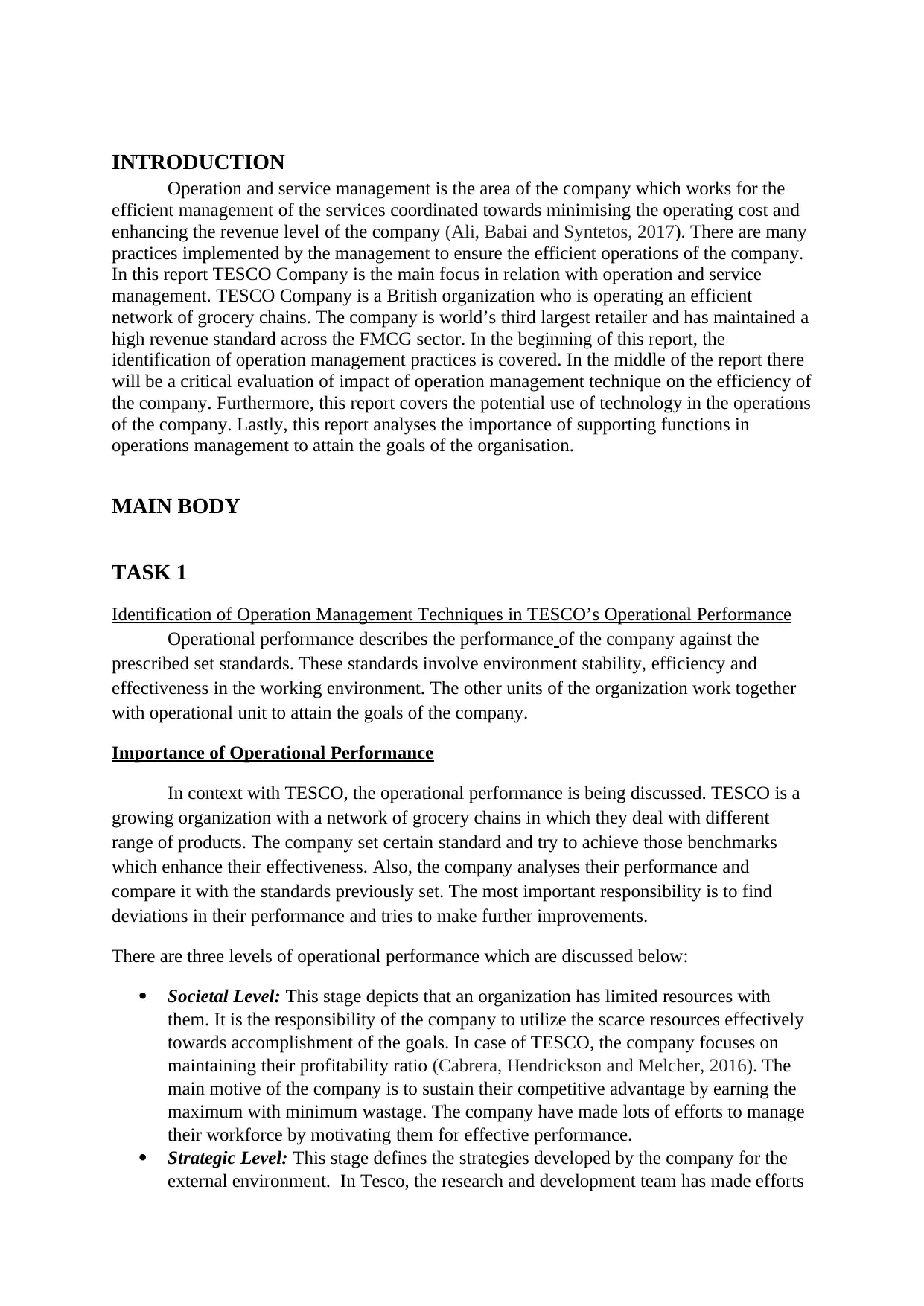
INTRODUCTION
Operation and service management is the area of the company which works for the
efficient management of the services coordinated towards minimising the operating cost and
enhancing the revenue level of the company (Ali, Babai and Syntetos, 2017). There are many
practices implemented by the management to ensure the efficient operations of the company.
In this report TESCO Company is the main focus in relation with operation and service
management. TESCO Company is a British organization who is operating an efficient
network of grocery chains. The company is world’s third largest retailer and has maintained a
high revenue standard across the FMCG sector. In the beginning of this report, the
identification of operation management practices is covered. In the middle of the report there
will be a critical evaluation of impact of operation management technique on the efficiency of
the company. Furthermore, this report covers the potential use of technology in the operations
of the company. Lastly, this report analyses the importance of supporting functions in
operations management to attain the goals of the organisation.
MAIN BODY
TASK 1
Identification of Operation Management Techniques in TESCO’s Operational Performance
Operational performance describes the performance of the company against the
prescribed set standards. These standards involve environment stability, efficiency and
effectiveness in the working environment. The other units of the organization work together
with operational unit to attain the goals of the company.
Importance of Operational Performance
In context with TESCO, the operational performance is being discussed. TESCO is a
growing organization with a network of grocery chains in which they deal with different
range of products. The company set certain standard and try to achieve those benchmarks
which enhance their effectiveness. Also, the company analyses their performance and
compare it with the standards previously set. The most important responsibility is to find
deviations in their performance and tries to make further improvements.
There are three levels of operational performance which are discussed below:
Societal Level: This stage depicts that an organization has limited resources with
them. It is the responsibility of the company to utilize the scarce resources effectively
towards accomplishment of the goals. In case of TESCO, the company focuses on
maintaining their profitability ratio (Cabrera, Hendrickson and Melcher, 2016). The
main motive of the company is to sustain their competitive advantage by earning the
maximum with minimum wastage. The company have made lots of efforts to manage
their workforce by motivating them for effective performance.
Strategic Level: This stage defines the strategies developed by the company for the
external environment. In Tesco, the research and development team has made efforts
Operation and service management is the area of the company which works for the
efficient management of the services coordinated towards minimising the operating cost and
enhancing the revenue level of the company (Ali, Babai and Syntetos, 2017). There are many
practices implemented by the management to ensure the efficient operations of the company.
In this report TESCO Company is the main focus in relation with operation and service
management. TESCO Company is a British organization who is operating an efficient
network of grocery chains. The company is world’s third largest retailer and has maintained a
high revenue standard across the FMCG sector. In the beginning of this report, the
identification of operation management practices is covered. In the middle of the report there
will be a critical evaluation of impact of operation management technique on the efficiency of
the company. Furthermore, this report covers the potential use of technology in the operations
of the company. Lastly, this report analyses the importance of supporting functions in
operations management to attain the goals of the organisation.
MAIN BODY
TASK 1
Identification of Operation Management Techniques in TESCO’s Operational Performance
Operational performance describes the performance of the company against the
prescribed set standards. These standards involve environment stability, efficiency and
effectiveness in the working environment. The other units of the organization work together
with operational unit to attain the goals of the company.
Importance of Operational Performance
In context with TESCO, the operational performance is being discussed. TESCO is a
growing organization with a network of grocery chains in which they deal with different
range of products. The company set certain standard and try to achieve those benchmarks
which enhance their effectiveness. Also, the company analyses their performance and
compare it with the standards previously set. The most important responsibility is to find
deviations in their performance and tries to make further improvements.
There are three levels of operational performance which are discussed below:
Societal Level: This stage depicts that an organization has limited resources with
them. It is the responsibility of the company to utilize the scarce resources effectively
towards accomplishment of the goals. In case of TESCO, the company focuses on
maintaining their profitability ratio (Cabrera, Hendrickson and Melcher, 2016). The
main motive of the company is to sustain their competitive advantage by earning the
maximum with minimum wastage. The company have made lots of efforts to manage
their workforce by motivating them for effective performance.
Strategic Level: This stage defines the strategies developed by the company for the
external environment. In Tesco, the research and development team has made efforts
⊘ This is a preview!⊘
Do you want full access?
Subscribe today to unlock all pages.

Trusted by 1+ million students worldwide
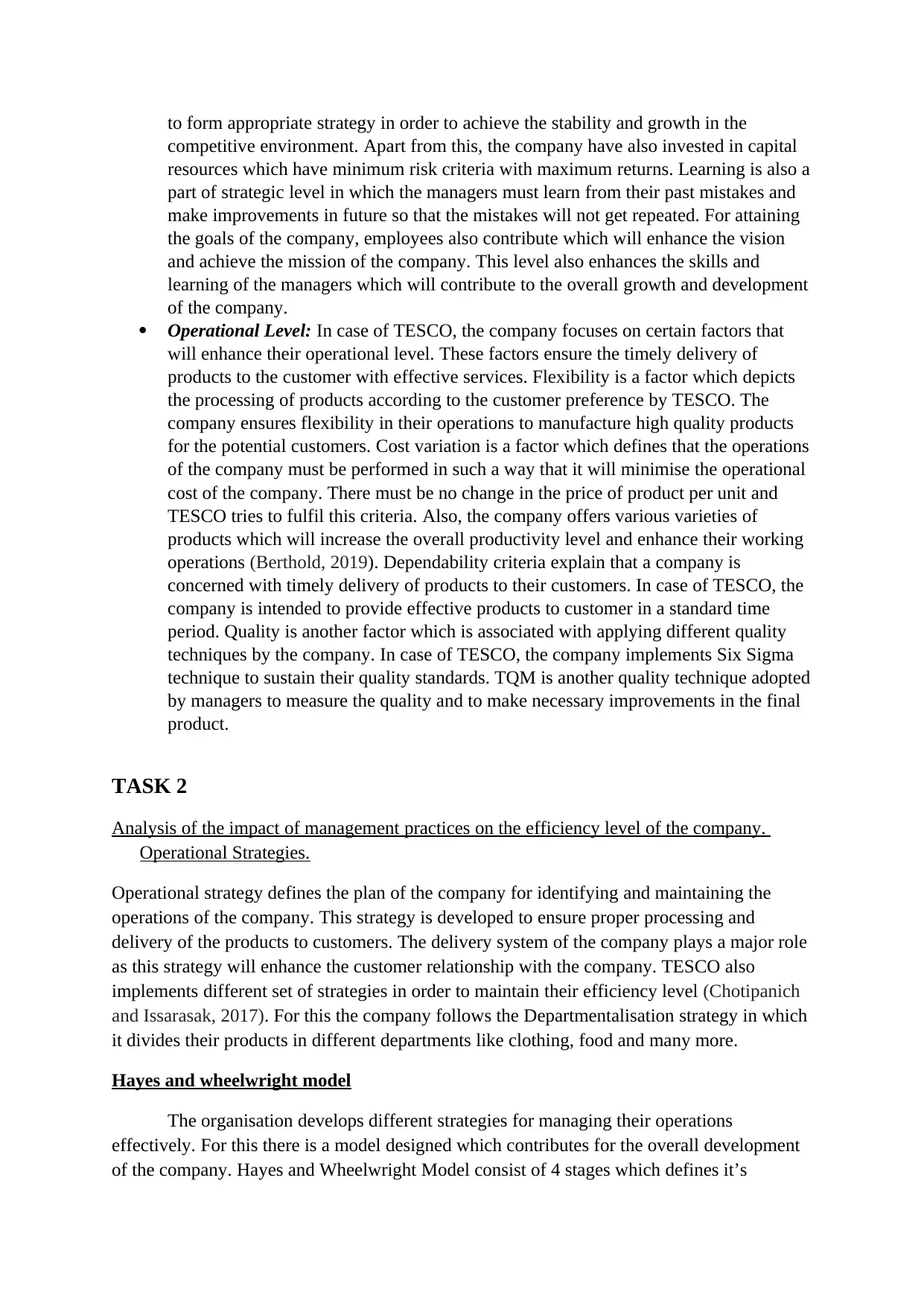
to form appropriate strategy in order to achieve the stability and growth in the
competitive environment. Apart from this, the company have also invested in capital
resources which have minimum risk criteria with maximum returns. Learning is also a
part of strategic level in which the managers must learn from their past mistakes and
make improvements in future so that the mistakes will not get repeated. For attaining
the goals of the company, employees also contribute which will enhance the vision
and achieve the mission of the company. This level also enhances the skills and
learning of the managers which will contribute to the overall growth and development
of the company.
Operational Level: In case of TESCO, the company focuses on certain factors that
will enhance their operational level. These factors ensure the timely delivery of
products to the customer with effective services. Flexibility is a factor which depicts
the processing of products according to the customer preference by TESCO. The
company ensures flexibility in their operations to manufacture high quality products
for the potential customers. Cost variation is a factor which defines that the operations
of the company must be performed in such a way that it will minimise the operational
cost of the company. There must be no change in the price of product per unit and
TESCO tries to fulfil this criteria. Also, the company offers various varieties of
products which will increase the overall productivity level and enhance their working
operations (Berthold, 2019). Dependability criteria explain that a company is
concerned with timely delivery of products to their customers. In case of TESCO, the
company is intended to provide effective products to customer in a standard time
period. Quality is another factor which is associated with applying different quality
techniques by the company. In case of TESCO, the company implements Six Sigma
technique to sustain their quality standards. TQM is another quality technique adopted
by managers to measure the quality and to make necessary improvements in the final
product.
TASK 2
Analysis of the impact of management practices on the efficiency level of the company.
Operational Strategies.
Operational strategy defines the plan of the company for identifying and maintaining the
operations of the company. This strategy is developed to ensure proper processing and
delivery of the products to customers. The delivery system of the company plays a major role
as this strategy will enhance the customer relationship with the company. TESCO also
implements different set of strategies in order to maintain their efficiency level (Chotipanich
and Issarasak, 2017). For this the company follows the Departmentalisation strategy in which
it divides their products in different departments like clothing, food and many more.
Hayes and wheelwright model
The organisation develops different strategies for managing their operations
effectively. For this there is a model designed which contributes for the overall development
of the company. Hayes and Wheelwright Model consist of 4 stages which defines it’s
competitive environment. Apart from this, the company have also invested in capital
resources which have minimum risk criteria with maximum returns. Learning is also a
part of strategic level in which the managers must learn from their past mistakes and
make improvements in future so that the mistakes will not get repeated. For attaining
the goals of the company, employees also contribute which will enhance the vision
and achieve the mission of the company. This level also enhances the skills and
learning of the managers which will contribute to the overall growth and development
of the company.
Operational Level: In case of TESCO, the company focuses on certain factors that
will enhance their operational level. These factors ensure the timely delivery of
products to the customer with effective services. Flexibility is a factor which depicts
the processing of products according to the customer preference by TESCO. The
company ensures flexibility in their operations to manufacture high quality products
for the potential customers. Cost variation is a factor which defines that the operations
of the company must be performed in such a way that it will minimise the operational
cost of the company. There must be no change in the price of product per unit and
TESCO tries to fulfil this criteria. Also, the company offers various varieties of
products which will increase the overall productivity level and enhance their working
operations (Berthold, 2019). Dependability criteria explain that a company is
concerned with timely delivery of products to their customers. In case of TESCO, the
company is intended to provide effective products to customer in a standard time
period. Quality is another factor which is associated with applying different quality
techniques by the company. In case of TESCO, the company implements Six Sigma
technique to sustain their quality standards. TQM is another quality technique adopted
by managers to measure the quality and to make necessary improvements in the final
product.
TASK 2
Analysis of the impact of management practices on the efficiency level of the company.
Operational Strategies.
Operational strategy defines the plan of the company for identifying and maintaining the
operations of the company. This strategy is developed to ensure proper processing and
delivery of the products to customers. The delivery system of the company plays a major role
as this strategy will enhance the customer relationship with the company. TESCO also
implements different set of strategies in order to maintain their efficiency level (Chotipanich
and Issarasak, 2017). For this the company follows the Departmentalisation strategy in which
it divides their products in different departments like clothing, food and many more.
Hayes and wheelwright model
The organisation develops different strategies for managing their operations
effectively. For this there is a model designed which contributes for the overall development
of the company. Hayes and Wheelwright Model consist of 4 stages which defines it’s
Paraphrase This Document
Need a fresh take? Get an instant paraphrase of this document with our AI Paraphraser

working. TESCO adopts this model to ensure that their competitive advantage is maintained
with effective operational performance of the company.
Stage 1 Correcting the Worst Problem.
This stage depicts the company’s biggest mistake in the operations of the company. In
context with TESCO, the company attempts to understand that where they are lacking in the
operational performance. This is analysed to maintain the neutral positivity in the company
which will prevent them from making another big blunders.
Stage 2 Adopting the Best Practice.
In this stage the company compares the external utility of the operational functions of
other companies with itself. In the context with TESCO, the company compares its
operations with different manufacturer in the industry to enhance their market share (El-
Gayar, Negm and Abdrabbo, 2018). Also, the company focuses on achieving their efficiency
level by enhancing their operations.
Stage 3 Linking the Strategies with Operations.
This stage involves aligning the operation strategy with overall business strategy. For
implementing this strategy, TESCO must ensure the support of the internal department and
form strategies to achieve the objective of the company. The strategies must be formed before
considering the objectives so that all the individual efforts must be combined together to
achieve the operational efficiency of TESCO.
Stage 4 Operational Advantage
This stage is also known as the external supportive stage which helps in the operations
of the company. In context with TESCO, the company uses their cretivite strategies to
enhance their productivity and sustain their competitive advantage in the industry.
TASK 3
Evaluation of technology which could help TESCO in processing and implantation of the
operations.
Process Design
Process Designing depicts the appropriateness of the process for the manufacturing
operations of the company (Gan and Zheng, 2019). Process design defines the broad view of
the organisation which will enhance the productivity of the company.
Importance of process design in operation management.
Innovation: It is the basic requirement of the process design of the organizations which will
drive the creativity of the operations. TESCO is operating in the international environment
where it is important for the company to implement innovation techniques which will
with effective operational performance of the company.
Stage 1 Correcting the Worst Problem.
This stage depicts the company’s biggest mistake in the operations of the company. In
context with TESCO, the company attempts to understand that where they are lacking in the
operational performance. This is analysed to maintain the neutral positivity in the company
which will prevent them from making another big blunders.
Stage 2 Adopting the Best Practice.
In this stage the company compares the external utility of the operational functions of
other companies with itself. In the context with TESCO, the company compares its
operations with different manufacturer in the industry to enhance their market share (El-
Gayar, Negm and Abdrabbo, 2018). Also, the company focuses on achieving their efficiency
level by enhancing their operations.
Stage 3 Linking the Strategies with Operations.
This stage involves aligning the operation strategy with overall business strategy. For
implementing this strategy, TESCO must ensure the support of the internal department and
form strategies to achieve the objective of the company. The strategies must be formed before
considering the objectives so that all the individual efforts must be combined together to
achieve the operational efficiency of TESCO.
Stage 4 Operational Advantage
This stage is also known as the external supportive stage which helps in the operations
of the company. In context with TESCO, the company uses their cretivite strategies to
enhance their productivity and sustain their competitive advantage in the industry.
TASK 3
Evaluation of technology which could help TESCO in processing and implantation of the
operations.
Process Design
Process Designing depicts the appropriateness of the process for the manufacturing
operations of the company (Gan and Zheng, 2019). Process design defines the broad view of
the organisation which will enhance the productivity of the company.
Importance of process design in operation management.
Innovation: It is the basic requirement of the process design of the organizations which will
drive the creativity of the operations. TESCO is operating in the international environment
where it is important for the company to implement innovation techniques which will
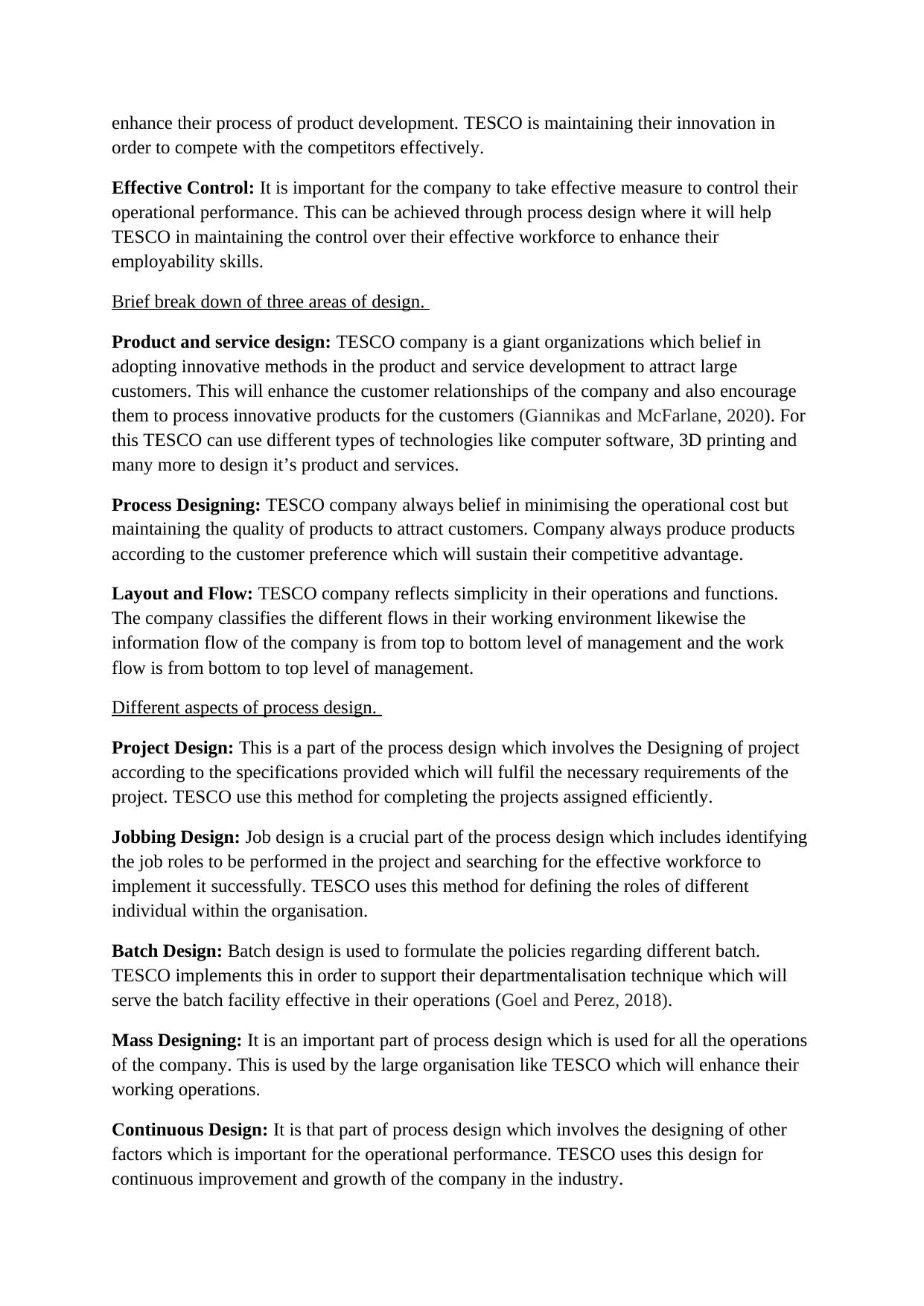
enhance their process of product development. TESCO is maintaining their innovation in
order to compete with the competitors effectively.
Effective Control: It is important for the company to take effective measure to control their
operational performance. This can be achieved through process design where it will help
TESCO in maintaining the control over their effective workforce to enhance their
employability skills.
Brief break down of three areas of design.
Product and service design: TESCO company is a giant organizations which belief in
adopting innovative methods in the product and service development to attract large
customers. This will enhance the customer relationships of the company and also encourage
them to process innovative products for the customers (Giannikas and McFarlane, 2020). For
this TESCO can use different types of technologies like computer software, 3D printing and
many more to design it’s product and services.
Process Designing: TESCO company always belief in minimising the operational cost but
maintaining the quality of products to attract customers. Company always produce products
according to the customer preference which will sustain their competitive advantage.
Layout and Flow: TESCO company reflects simplicity in their operations and functions.
The company classifies the different flows in their working environment likewise the
information flow of the company is from top to bottom level of management and the work
flow is from bottom to top level of management.
Different aspects of process design.
Project Design: This is a part of the process design which involves the Designing of project
according to the specifications provided which will fulfil the necessary requirements of the
project. TESCO use this method for completing the projects assigned efficiently.
Jobbing Design: Job design is a crucial part of the process design which includes identifying
the job roles to be performed in the project and searching for the effective workforce to
implement it successfully. TESCO uses this method for defining the roles of different
individual within the organisation.
Batch Design: Batch design is used to formulate the policies regarding different batch.
TESCO implements this in order to support their departmentalisation technique which will
serve the batch facility effective in their operations (Goel and Perez, 2018).
Mass Designing: It is an important part of process design which is used for all the operations
of the company. This is used by the large organisation like TESCO which will enhance their
working operations.
Continuous Design: It is that part of process design which involves the designing of other
factors which is important for the operational performance. TESCO uses this design for
continuous improvement and growth of the company in the industry.
order to compete with the competitors effectively.
Effective Control: It is important for the company to take effective measure to control their
operational performance. This can be achieved through process design where it will help
TESCO in maintaining the control over their effective workforce to enhance their
employability skills.
Brief break down of three areas of design.
Product and service design: TESCO company is a giant organizations which belief in
adopting innovative methods in the product and service development to attract large
customers. This will enhance the customer relationships of the company and also encourage
them to process innovative products for the customers (Giannikas and McFarlane, 2020). For
this TESCO can use different types of technologies like computer software, 3D printing and
many more to design it’s product and services.
Process Designing: TESCO company always belief in minimising the operational cost but
maintaining the quality of products to attract customers. Company always produce products
according to the customer preference which will sustain their competitive advantage.
Layout and Flow: TESCO company reflects simplicity in their operations and functions.
The company classifies the different flows in their working environment likewise the
information flow of the company is from top to bottom level of management and the work
flow is from bottom to top level of management.
Different aspects of process design.
Project Design: This is a part of the process design which involves the Designing of project
according to the specifications provided which will fulfil the necessary requirements of the
project. TESCO use this method for completing the projects assigned efficiently.
Jobbing Design: Job design is a crucial part of the process design which includes identifying
the job roles to be performed in the project and searching for the effective workforce to
implement it successfully. TESCO uses this method for defining the roles of different
individual within the organisation.
Batch Design: Batch design is used to formulate the policies regarding different batch.
TESCO implements this in order to support their departmentalisation technique which will
serve the batch facility effective in their operations (Goel and Perez, 2018).
Mass Designing: It is an important part of process design which is used for all the operations
of the company. This is used by the large organisation like TESCO which will enhance their
working operations.
Continuous Design: It is that part of process design which involves the designing of other
factors which is important for the operational performance. TESCO uses this design for
continuous improvement and growth of the company in the industry.
⊘ This is a preview!⊘
Do you want full access?
Subscribe today to unlock all pages.

Trusted by 1+ million students worldwide

TASK 4
Analysing and linking supporting functions to the operation management within the
organisation.
It is important for a company to utilise its resources for achieving the efficiency level
in their operations. The company focuses on implementing the operational strategies,
operational planning and operational techniques towards the attainment of goals of the
company. This will enhance the revenue and productivity of the company in the external
environment. The company operates in the competitive industry and to sustain their growth it
is important to make effective use of technology (Ivanov, 2018). Also, the company can
make creative use of resources which will enhance the product development of the company.
For this the company can use quality management techniques which will attract potential
customers towards the brand. This will help the company in understanding the customers’
expectations and they can develop the product accordingly.
Operation management within the organisation plays a major role in their working.
This will help the company in enhancing their productivity and quality and management of
their operations. The company also formulate different policies and programmes which fulfil
the customer satisfaction. It also bridges the gap between the process and services of TESCO.
The company serves difference products which provide different qualities to the customer
and enhance the customer base (Qu, Perkins and Olsen, 2018). Functionality of TESCO can
be improved by effectively using the workforce and their value added skills which will
provide the customer with different options in their product range. TESCO adopts this for
improving their customer relationship and providing good infrastructure facilities to their
customer. The company also develops different social norms which can be used enhance the
reliability of the customer on the products of the brand.
This also increases the durability of product by adopting the latest and effective
technology which will reduce the hard work. This will also encourage smart in the operations
of the company. The company’s relation with its competitors will also get improved as their
customer base is increasing day by day. Operations management will also help in brand
recognition of TESCO as the company is working according to the customer’s preference.
The products and service management of the company can be re-engineered in order to
maintain their efficient product life cycle (Liu, Lu and Deng, 2019). This will provide wide
range of products to the customer. TESCO is famous for its grocery chains and the company
is managing their connections with the chain network effectively to take advantage of their
future growth prospects. TESCO has the system which is filled with effective ideas and
products to enhance their operational performance.
The company is also famous for their loyalty cards system for the customers which
have built strong trust of the customers over the brand. This has enhanced the sales and
revenue of the company towards the development of company’s goals. Due to the integration
of IT with the operations of the company this has served the customer in an innovative way.
The company believes in adopting the modern system which will ensure the company’s
progress and prosperity. The company also have the effective supplier management that
Analysing and linking supporting functions to the operation management within the
organisation.
It is important for a company to utilise its resources for achieving the efficiency level
in their operations. The company focuses on implementing the operational strategies,
operational planning and operational techniques towards the attainment of goals of the
company. This will enhance the revenue and productivity of the company in the external
environment. The company operates in the competitive industry and to sustain their growth it
is important to make effective use of technology (Ivanov, 2018). Also, the company can
make creative use of resources which will enhance the product development of the company.
For this the company can use quality management techniques which will attract potential
customers towards the brand. This will help the company in understanding the customers’
expectations and they can develop the product accordingly.
Operation management within the organisation plays a major role in their working.
This will help the company in enhancing their productivity and quality and management of
their operations. The company also formulate different policies and programmes which fulfil
the customer satisfaction. It also bridges the gap between the process and services of TESCO.
The company serves difference products which provide different qualities to the customer
and enhance the customer base (Qu, Perkins and Olsen, 2018). Functionality of TESCO can
be improved by effectively using the workforce and their value added skills which will
provide the customer with different options in their product range. TESCO adopts this for
improving their customer relationship and providing good infrastructure facilities to their
customer. The company also develops different social norms which can be used enhance the
reliability of the customer on the products of the brand.
This also increases the durability of product by adopting the latest and effective
technology which will reduce the hard work. This will also encourage smart in the operations
of the company. The company’s relation with its competitors will also get improved as their
customer base is increasing day by day. Operations management will also help in brand
recognition of TESCO as the company is working according to the customer’s preference.
The products and service management of the company can be re-engineered in order to
maintain their efficient product life cycle (Liu, Lu and Deng, 2019). This will provide wide
range of products to the customer. TESCO is famous for its grocery chains and the company
is managing their connections with the chain network effectively to take advantage of their
future growth prospects. TESCO has the system which is filled with effective ideas and
products to enhance their operational performance.
The company is also famous for their loyalty cards system for the customers which
have built strong trust of the customers over the brand. This has enhanced the sales and
revenue of the company towards the development of company’s goals. Due to the integration
of IT with the operations of the company this has served the customer in an innovative way.
The company believes in adopting the modern system which will ensure the company’s
progress and prosperity. The company also have the effective supplier management that
Paraphrase This Document
Need a fresh take? Get an instant paraphrase of this document with our AI Paraphraser
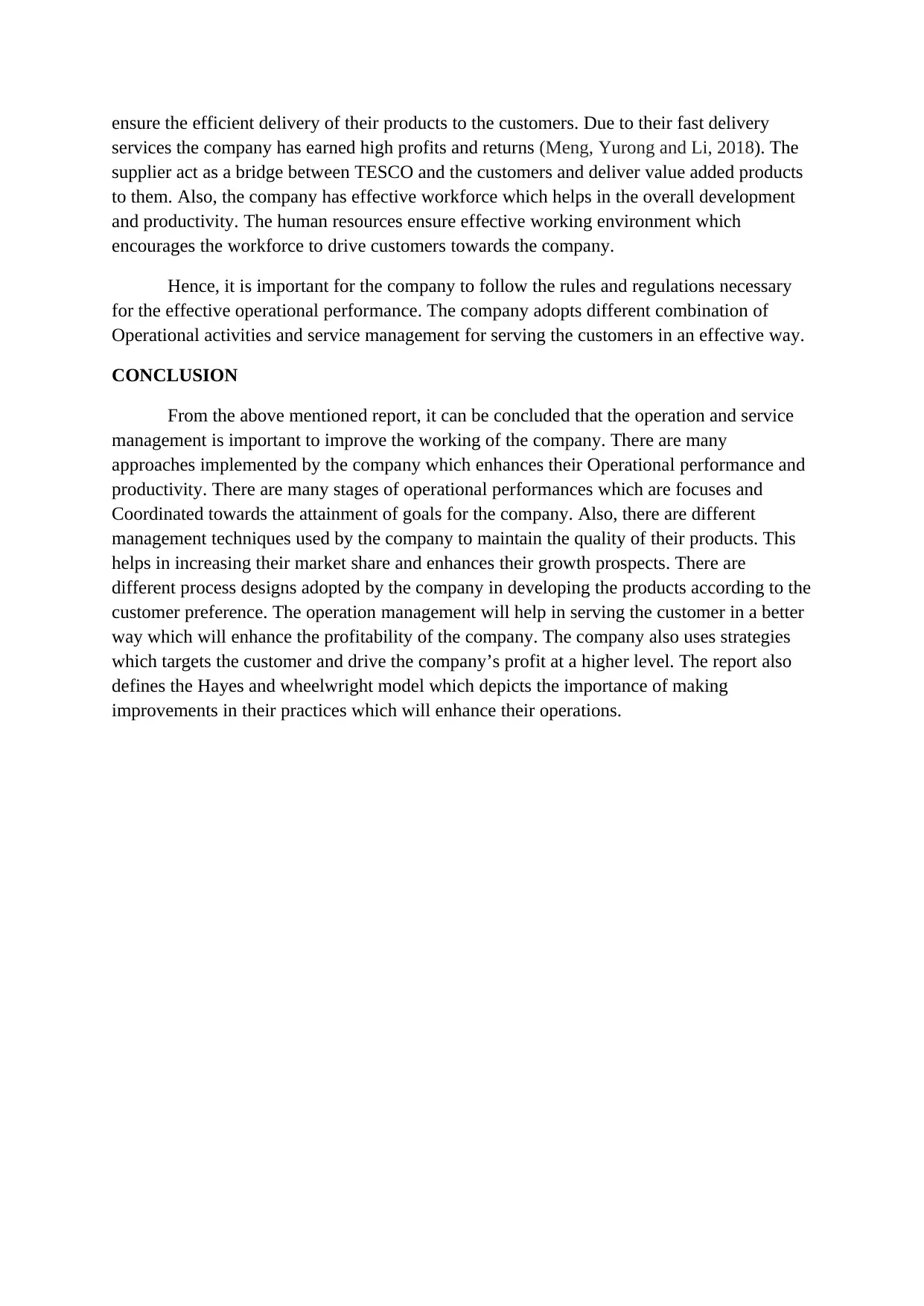
ensure the efficient delivery of their products to the customers. Due to their fast delivery
services the company has earned high profits and returns (Meng, Yurong and Li, 2018). The
supplier act as a bridge between TESCO and the customers and deliver value added products
to them. Also, the company has effective workforce which helps in the overall development
and productivity. The human resources ensure effective working environment which
encourages the workforce to drive customers towards the company.
Hence, it is important for the company to follow the rules and regulations necessary
for the effective operational performance. The company adopts different combination of
Operational activities and service management for serving the customers in an effective way.
CONCLUSION
From the above mentioned report, it can be concluded that the operation and service
management is important to improve the working of the company. There are many
approaches implemented by the company which enhances their Operational performance and
productivity. There are many stages of operational performances which are focuses and
Coordinated towards the attainment of goals for the company. Also, there are different
management techniques used by the company to maintain the quality of their products. This
helps in increasing their market share and enhances their growth prospects. There are
different process designs adopted by the company in developing the products according to the
customer preference. The operation management will help in serving the customer in a better
way which will enhance the profitability of the company. The company also uses strategies
which targets the customer and drive the company’s profit at a higher level. The report also
defines the Hayes and wheelwright model which depicts the importance of making
improvements in their practices which will enhance their operations.
services the company has earned high profits and returns (Meng, Yurong and Li, 2018). The
supplier act as a bridge between TESCO and the customers and deliver value added products
to them. Also, the company has effective workforce which helps in the overall development
and productivity. The human resources ensure effective working environment which
encourages the workforce to drive customers towards the company.
Hence, it is important for the company to follow the rules and regulations necessary
for the effective operational performance. The company adopts different combination of
Operational activities and service management for serving the customers in an effective way.
CONCLUSION
From the above mentioned report, it can be concluded that the operation and service
management is important to improve the working of the company. There are many
approaches implemented by the company which enhances their Operational performance and
productivity. There are many stages of operational performances which are focuses and
Coordinated towards the attainment of goals for the company. Also, there are different
management techniques used by the company to maintain the quality of their products. This
helps in increasing their market share and enhances their growth prospects. There are
different process designs adopted by the company in developing the products according to the
customer preference. The operation management will help in serving the customer in a better
way which will enhance the profitability of the company. The company also uses strategies
which targets the customer and drive the company’s profit at a higher level. The report also
defines the Hayes and wheelwright model which depicts the importance of making
improvements in their practices which will enhance their operations.
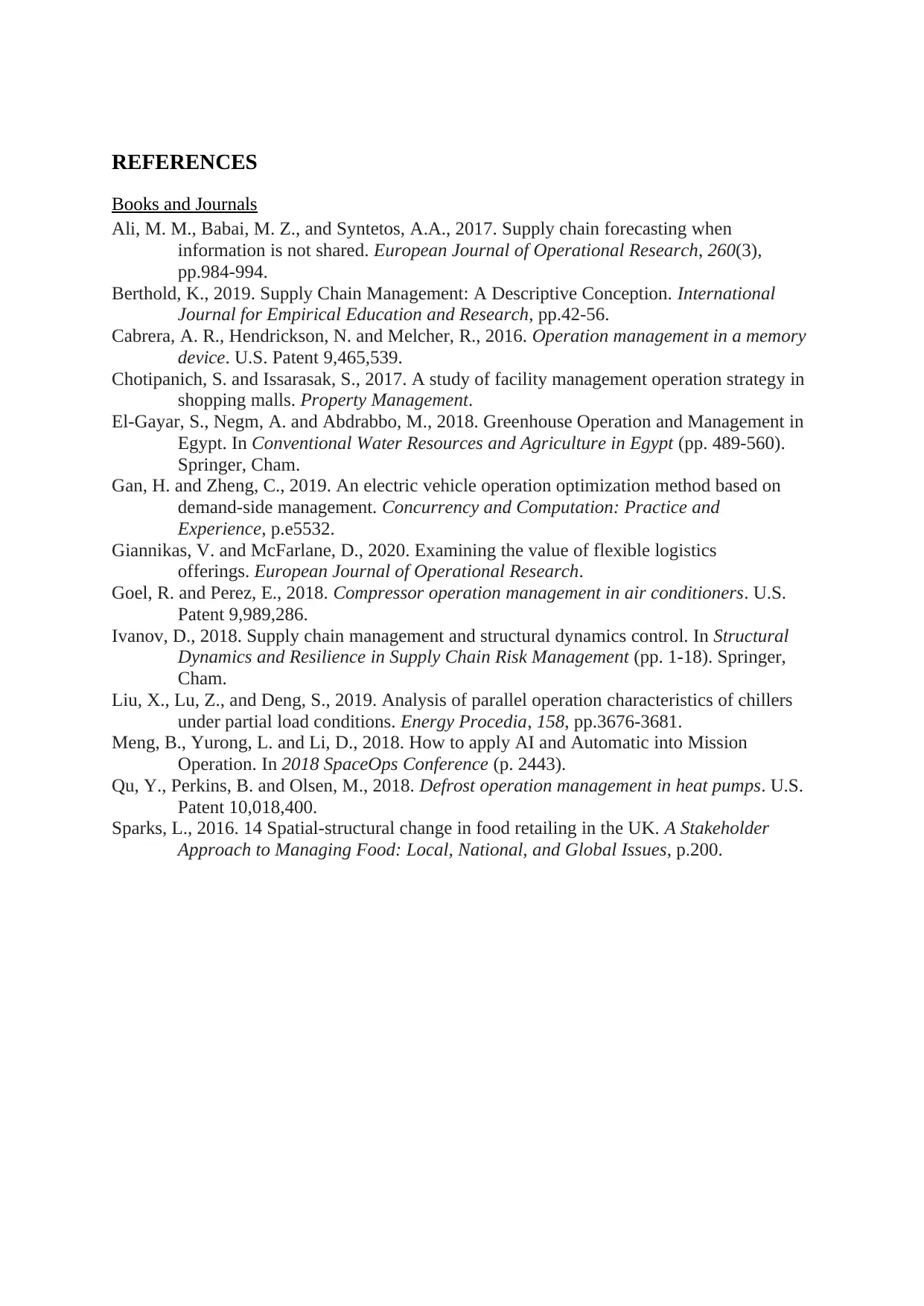
REFERENCES
Books and Journals
Ali, M. M., Babai, M. Z., and Syntetos, A.A., 2017. Supply chain forecasting when
information is not shared. European Journal of Operational Research, 260(3),
pp.984-994.
Berthold, K., 2019. Supply Chain Management: A Descriptive Conception. International
Journal for Empirical Education and Research, pp.42-56.
Cabrera, A. R., Hendrickson, N. and Melcher, R., 2016. Operation management in a memory
device. U.S. Patent 9,465,539.
Chotipanich, S. and Issarasak, S., 2017. A study of facility management operation strategy in
shopping malls. Property Management.
El-Gayar, S., Negm, A. and Abdrabbo, M., 2018. Greenhouse Operation and Management in
Egypt. In Conventional Water Resources and Agriculture in Egypt (pp. 489-560).
Springer, Cham.
Gan, H. and Zheng, C., 2019. An electric vehicle operation optimization method based on
demand‐side management. Concurrency and Computation: Practice and
Experience, p.e5532.
Giannikas, V. and McFarlane, D., 2020. Examining the value of flexible logistics
offerings. European Journal of Operational Research.
Goel, R. and Perez, E., 2018. Compressor operation management in air conditioners. U.S.
Patent 9,989,286.
Ivanov, D., 2018. Supply chain management and structural dynamics control. In Structural
Dynamics and Resilience in Supply Chain Risk Management (pp. 1-18). Springer,
Cham.
Liu, X., Lu, Z., and Deng, S., 2019. Analysis of parallel operation characteristics of chillers
under partial load conditions. Energy Procedia, 158, pp.3676-3681.
Meng, B., Yurong, L. and Li, D., 2018. How to apply AI and Automatic into Mission
Operation. In 2018 SpaceOps Conference (p. 2443).
Qu, Y., Perkins, B. and Olsen, M., 2018. Defrost operation management in heat pumps. U.S.
Patent 10,018,400.
Sparks, L., 2016. 14 Spatial-structural change in food retailing in the UK. A Stakeholder
Approach to Managing Food: Local, National, and Global Issues, p.200.
Books and Journals
Ali, M. M., Babai, M. Z., and Syntetos, A.A., 2017. Supply chain forecasting when
information is not shared. European Journal of Operational Research, 260(3),
pp.984-994.
Berthold, K., 2019. Supply Chain Management: A Descriptive Conception. International
Journal for Empirical Education and Research, pp.42-56.
Cabrera, A. R., Hendrickson, N. and Melcher, R., 2016. Operation management in a memory
device. U.S. Patent 9,465,539.
Chotipanich, S. and Issarasak, S., 2017. A study of facility management operation strategy in
shopping malls. Property Management.
El-Gayar, S., Negm, A. and Abdrabbo, M., 2018. Greenhouse Operation and Management in
Egypt. In Conventional Water Resources and Agriculture in Egypt (pp. 489-560).
Springer, Cham.
Gan, H. and Zheng, C., 2019. An electric vehicle operation optimization method based on
demand‐side management. Concurrency and Computation: Practice and
Experience, p.e5532.
Giannikas, V. and McFarlane, D., 2020. Examining the value of flexible logistics
offerings. European Journal of Operational Research.
Goel, R. and Perez, E., 2018. Compressor operation management in air conditioners. U.S.
Patent 9,989,286.
Ivanov, D., 2018. Supply chain management and structural dynamics control. In Structural
Dynamics and Resilience in Supply Chain Risk Management (pp. 1-18). Springer,
Cham.
Liu, X., Lu, Z., and Deng, S., 2019. Analysis of parallel operation characteristics of chillers
under partial load conditions. Energy Procedia, 158, pp.3676-3681.
Meng, B., Yurong, L. and Li, D., 2018. How to apply AI and Automatic into Mission
Operation. In 2018 SpaceOps Conference (p. 2443).
Qu, Y., Perkins, B. and Olsen, M., 2018. Defrost operation management in heat pumps. U.S.
Patent 10,018,400.
Sparks, L., 2016. 14 Spatial-structural change in food retailing in the UK. A Stakeholder
Approach to Managing Food: Local, National, and Global Issues, p.200.
⊘ This is a preview!⊘
Do you want full access?
Subscribe today to unlock all pages.

Trusted by 1+ million students worldwide
1 out of 9
Related Documents
Your All-in-One AI-Powered Toolkit for Academic Success.
+13062052269
info@desklib.com
Available 24*7 on WhatsApp / Email
![[object Object]](/_next/static/media/star-bottom.7253800d.svg)
Unlock your academic potential
Copyright © 2020–2025 A2Z Services. All Rights Reserved. Developed and managed by ZUCOL.





